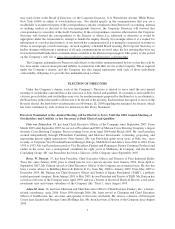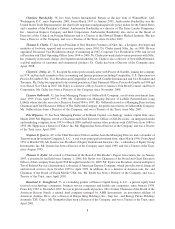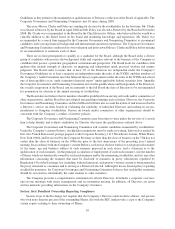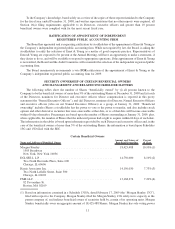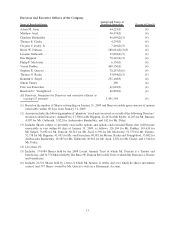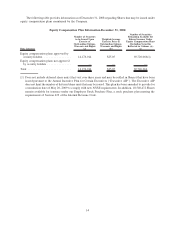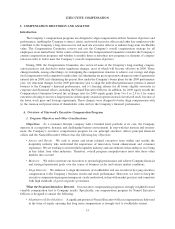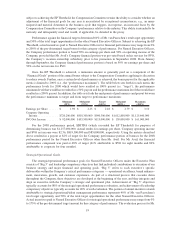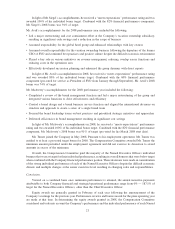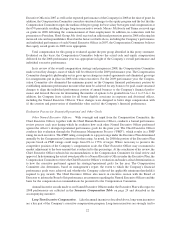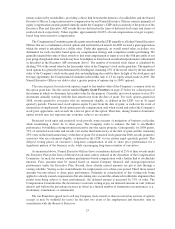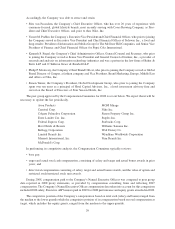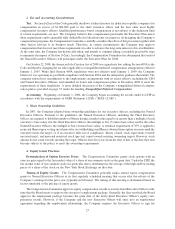Starwood 2008 Annual Report Download - page 29
Download and view the complete annual report
Please find page 29 of the 2008 Starwood annual report below. You can navigate through the pages in the report by either clicking on the pages listed below, or by using the keyword search tool below to find specific information within the annual report.B. Elements of Compensation
1. Primary Elements
The primary elements of the Company’s compensation program for our Named Executive Officers are:
• Base Salary
• Incentive Compensation
OAnnual Incentive Compensation
OLong-Term Incentive Compensation
• Benefits and Perquisites
Mr. van Paasschen’s compensation structure was established in 2007 pursuant to his employment agreement.
Mr. van Paasschen and the Company agreed to a compensation structure which was heavily geared towards
performance and long term incentives, including equity awards in the form of restricted stock and stock options and
restrictions on selling equity awards for two years (other than to satisfy tax withholding obligations). As a result, in
the event of strong financial and individual performance, Mr. van Paasschen would benefit greatly in the form of
long term incentive compensation (stock options and restricted stock), but his compensation would be significantly
lower if the Company did not perform well or if his employment with the Company was terminated after a short
period of time (due to the vesting requirements of the equity awards and generally no acceleration of equity awards
for a termination with or without cause). For the other Named Executive Officers, pay is also structured to award
performance but to a lesser degree in order to provide the Named Executive Officers with a minimum amount of
compensation when the Company is unable to achieve its financial and strategic goals.
We describe each of the compensation elements below and explain why we pay each element and how we
determine the amount of each element.
Base Salary. The Company believes it is essential to provide our Named Executive Officers with com-
petitive base salaries that will enable the Company to continue to attract and retain critical senior executives from
within and outside the hospitality industry. In the case of Named Executive Officers other than the Chief Executive
Officer, base salary typically accounts for approximately 20% of total compensation at target, i.e., total compen-
sation excluding benefits and perquisites, and is generally targeted at the median of the Company’s peer group. In
the case of Mr. van Paasschen, base salary for 2008 was limited to $1 million in order to keep this element of his
compensation below the levels established by Section 162(m) of the Internal Revenue Code of 1986, as amended
(the “Code”), which limits the deductibility of non-performance-based compensation above that amount. As a
result, base salary accounted for approximately 12.5% of total compensation at target for Mr. van Paasschen. Base
salary serves as a minimum level of compensation to Named Executive Officers in circumstances when achieving
Company financial and strategic/operational objectives becomes challenging and the level of incentive compen-
sation is impacted. Salaries for Named Executive Officers are generally based on the responsibilities of each
position and are reviewed annually against similar positions among a group of peer companies developed by the
Company and its advisors consisting of similarly-sized hotel and hospitality companies as well as other companies
representative of markets in which the Company competes for key executive talent. See the Background
Information on the Executive Compensation Program — Use of Peer Data section beginning on page 25 below
for a list of the peer companies used in this analysis. The Company generally seeks to position base salaries of our
Named Executive Officers at or near the market median for similar positions.
Incentive Compensation. Incentive compensation includes annual incentive awards under the Company’s
Annual Incentive Plan for Certain Executives (the “Executive Plan”) as well as long-term incentive compensation in
the form of equity awards under the Company’s 2004 Long-Term Incentive Plan (“LTIP”). Incentive compensation
typically accounts for approximately 80% of total compensation at target (87.5% for Mr. van Paasschen), with
annual incentive compensation and long-term incentive compensation accounting for 20% and 60%, respectively
(25% and 62.5% for Mr. van Paasschen, respectively). The Company’s emphasis on incentive compensation results
in total compensation at target that is set at approximately the 65th percentile level relative to the Company’s peer
group, but that is highly dependent on performance. The Company believes that this structure allows it to provide
17


